


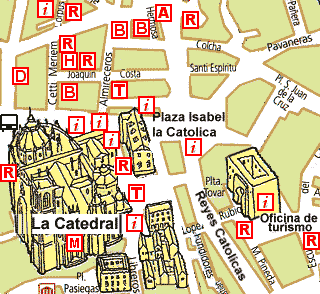
PLAZA ISABEL LA CATÓLICA
1 of 2
The statue in this square shows Queen Isabel granting Columbus' petition to obtain ships and supplies. The statue was built in Rome in 1892 by Mariano Benlliure and was originally located in the Paseo del Salón.
As is the case of most Christian buildings in Granada, the Cathedral was built on the site of the former Mosque. The site of the former Mosque has since been replaced by four buildings: the Cathedral, the Royal Chapel, the Sagrario, and the Merchants' Exchange.
Granada Cathedral: 16th century - on site of former main mosque - Gran Vía
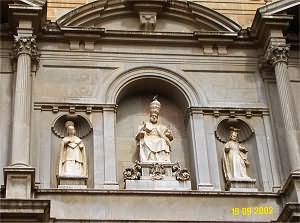 For me, the most striking fact about the cathedral is the incredibly long time it took to build. Work on the cathedral began on 15th March 1523 and it was not
For me, the most striking fact about the cathedral is the incredibly long time it took to build. Work on the cathedral began on 15th March 1523 and it was not
There is a restaurant at the back of the cathedral called the Via Colón.
See information about the Gypsy fortune tellers who frequent the area around the cathedral here.

ROYAL CHAPEL
Royal Chapel: 16th century - tombs of Monarchs Isabel, Fernando, Juan & Felipe - Gran Vía
Designs for the Royal Chapel began in 1504 and it was built between 1505 and 1521 by Enrique Egas. It was commissioned by the Catholic Monarchs for their burial site. As both Queen Isabel and King Fernando died before the Royal Chapel was finished, they were first buried in the Friary of San Francisco in the Alhambra. They were then later moved to the Chapel once it had been completed , and buried alongside King Felipe and Queen Juana (known more commonly as Juana la Loca - Juana the Mad). Although their original idea was for all future Spanish Kings and Queens to be buried here, this did not happen as the monastery in El Escorial was used instead. The tombs were carved out of marble by the Tuscan sculptor Domenico Fancelli.
This was the last gothic church to be built in Spain as Isabel and Fernando did not like the new renaissance style of the time.
Four buildings now stand on the site where the Main Mosque used to stand: the Royal Chapel, theCathedral, the Merchants' Exchange, and the Church of the Sagrario. The only thing left today of the Mosque is a well outside the chapel and it was here that ablutions were perfomed before entering.
The altarpiece consists of four painted wooden panels showing the Conquest of Granada, one of which shows Moors being baptised. On either side of the altar there are the two praying statues of Isabel and Fernando. The chapel also houses Isabel's art collection.
CORRAL DE CARBÓN
Corral de Carbón: oldest Arabic monument in Spain - spectacular doorway and simple courtyard - Calle Reyes Católicos
The Corral de Carbon is located on Calle Reyes Católicos and is the oldest monument from Arab times in Spain. It consists of a spectacular doorway (see photo) with a contrastingly simple interior courtyard. It now belongs to the Junta de Andalucía and contains shops and offices. It is worth a quick visit.
The Corral de Carbón was built in 1336 by Yussuf I. It was orginally a corn exchange and store in Arab times, and merchants and carters would stay here. After the Christian conquest, theCatholic Monarchs allowed one of their servants to live here and when he died without heirs, it was sold by public auction . By now it was called the Corral de Carbón as coal merchants would stay here, and their coal weighed nearby. It was also used as a theatre at the beginning of the 16th century.




BAÑUELO
El Bañuelo: original 11th century Arabic baths - along the River Darro opposite the Alhambra
These baths used to be part of the Mosque of the Walnut Tree (Mezquita del Nogal) which previously stood here. They were built in the 11th century and are considered to be among the oldest and mostcomplete baths in Spain. This was a traditional meeting for place for locals, who would come here for haircuts and massages. There were different times for men and women, who would seldom leave their homes (except for a weekly visit to the cemetery and a once or twice monthly visit to the baths). Brides-to-be would also come here before their weddings.
You enter the baths through a small house which was reconstructed in Christian times. At the end of a small hallway (zaguán), there is a courtyard with a pool (alberca) and from here you can access the baths themselves, with their three rooms: cool room, (sala de refresco), central room (sala central) and finally, the hot room (sala caliente). The columns were taken from Roman and Visigothic ruins and the octagonal or star-shaped holes in the roof allowed light to enter and steam to escape. They alsoreduced the weight of the roof.
Alcaicería: former silk market, now narrow streets with souvenir shops
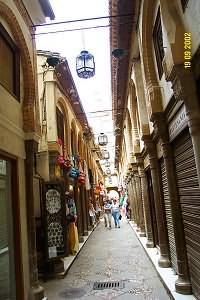 This is now taken up with souvenir shops but it was once a great bazaar where silk was made and sold. Alcaicería literally means either the "house of Caesar" or "belonging to Caesar" in recognition of the fact that Emperor Justinian granted the Moors permission to sell silk. Traditionally these bazaars were situated in the centre of a city, with
This is now taken up with souvenir shops but it was once a great bazaar where silk was made and sold. Alcaicería literally means either the "house of Caesar" or "belonging to Caesar" in recognition of the fact that Emperor Justinian granted the Moors permission to sell silk. Traditionally these bazaars were situated in the centre of a city, with
On the night of the 19th July 1843, a fire broke out in one of the shops making matches in nearby Calle Mesones and consequently the entire original bazaar burned down. It was soon rebuilt but never regained its importance as a bazaar.
CALLE ZACATÍN
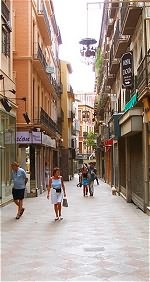
Zacatín: main shopping street, previously where craftsmen were based
This street used to stretch from Plaza Bibarrambla all the way to Plaza Nueva, running parallel to theDarro before the river was covered over. However, at the beginning of the 19th century the upper part nearest to Plaza Nueva was lost when the Gran Vía was redesigned.
Zacatín means "Clothes Market" and it was here that textiles and cloth used to be sold in the lower part of the street in Moorish times, when it was nothing more than a series of dirt huts on the river bank. There was also a potpourri of all other sorts of craftsmen such as silversmiths, tanners, dyers , tailors, shoemakers, hatters, haberdashers in the area and some street names reflecting these activities still survive today. From 1491 onwards, in order to create a better sense of order, the whole area was reorganised and the different trades were each allocated a different zone. The silversmiths therefore were relocated to the main entrance to the Alcaicería.
PLAZA BIBARRAMBLA
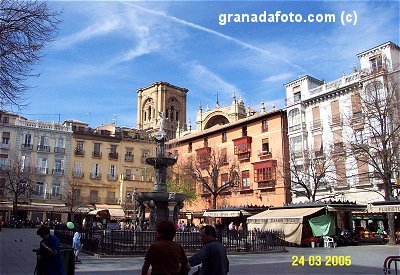
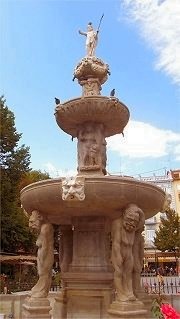 The name Bibarrambla mean "Gate of the River" since the square originally stood on the sandy river bank. In Moorish times, festivals and jousts were held here, and later in Christian times bullfights. Unlike the bullfights of today, these were extremely violent and during one which took place in August 1609, 20 bulls killed 36 people and injured another 60.
The name Bibarrambla mean "Gate of the River" since the square originally stood on the sandy river bank. In Moorish times, festivals and jousts were held here, and later in Christian times bullfights. Unlike the bullfights of today, these were extremely violent and during one which took place in August 1609, 20 bulls killed 36 people and injured another 60.
Following the Christian conquest, however, the autos-da-fé were held here to decide the fate of many citizens . Many important Arabic manuscripts, documents and books, (particularly Korans) were also burnt, as they were in other public squares all over Granda, and it is thought that as many as 1,000,000 were destroyed in this way.
Over time, many changes have been made. Arched buildings were built on one of the sides where the city scribes worked, and customs houses were set up to control the spices and textiles being brought in. This was also where horse fairs were held.
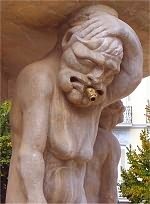 As you enter the square from Zacatín, in the 16th century the streets on the left didn't use to exist in the 16th century, and this was where the fish and meat markets were located. Later the square was used for a vegetable market but this was abolished in 1837 and a fountain and a platform erected in the middle, constructed from materials from nearby convents which had been demolished. The meat and
As you enter the square from Zacatín, in the 16th century the streets on the left didn't use to exist in the 16th century, and this was where the fish and meat markets were located. Later the square was used for a vegetable market but this was abolished in 1837 and a fountain and a platform erected in the middle, constructed from materials from nearby convents which had been demolished. The meat and Paseo de los Tristes and the Rio Darro in Granada
Paseo de los Tristes offers stunning views of the Alhambra and begins at the point where it crosses the Bridge of the Chirimias; the Chirimias are a kind of flute that was once played from a balcony or veranda built there for such use.
Although the Paseo de los Tristes is officially called Andres Manjon, it is known by this name because funeral processions on the way to the cemetery once passed through it.

Paseo de los Tristes was laid out in 1609 on land provided by the Lords of Castril. There still exists the small building with a tall square-shaped tower and façade decorated with the shields of Granada, near the high bridge of Chirimias. The fountain in the middle of the Paseo de los Tristes dates from 1609.
To the left of the Paseo de los Tristes, facing the Alhambra, extended the Districo of the Axares. The Moors called it the Hospital of Africa for its beauty and cool climate.
How to Get to the Paseo de los Tristes

For more information, see Alhambra buses and urban buses.
Carrera del Darro is name is given to the entire left bank of the River Darro, and should not be confused with the Acera del Darro.

Carrera del Darro is one of the most scenic walks in Granada. To the right of the River Darro, it is crossed by two brick and stone bridges (Cabrera and Espinosa), which link Carrera del Darro with the neighborhood of the Churra. It runs between the river, the forest of the Alhambra and the Almanzora, which extends up the slope of Gomerez.
 The street dates from the seventeenth century. Because of the damage caused in 1509 by the explosion of an ammunition dumo near the Church of St. Peter, part of the wall that ran here was demolished which changed the direction of the river, hence widening the street.
The street dates from the seventeenth century. Because of the damage caused in 1509 by the explosion of an ammunition dumo near the Church of St. Peter, part of the wall that ran here was demolished which changed the direction of the river, hence widening the street.
Carrera del Darro in Granada retains many interesting buildings from the sixteenth and seventeenth centuries and there are remains of Arab houses. buildings of the SS. XVI and XVII and there are the remains of Arab houses.

From Plaza Nueva in Granada, you can walk up to the Alhambra or sit in one of the terraces andhave a beer after visiting Granada's monuments.
Around the square are several important buildings such as the Royal Chancellery and the House of Pisa, and nearby is the lively Calle Elvira, from where you can reach the Albaycin
 The Plaza Nueva was formerly one of the most important parts of the city where various tournaments, games and bullfights were held.
The Plaza Nueva was formerly one of the most important parts of the city where various tournaments, games and bullfights were held.
Spread over the Darro River, which now runs underground, it was founded in the Christian era. Once the bridge of al-Hattabin (Bridge of Loggers) on the River Darro joined the Plaza de San Gil with the current Cuchilleros.
In 1499, the bridge was widened with a brick arch made by the moor Ali de Mediana, but it was not enough to support a great number of people crossing the river, and in August 1506 the formation of the square was authorized.
 The Plaza Nueva was initially laid out as far as the slope of the Gomerez, but it was later extended to the modern Plaza of Santa Ana, completed in 1515 by the mason Miguel Sanchez de Toledo.
The Plaza Nueva was initially laid out as far as the slope of the Gomerez, but it was later extended to the modern Plaza of Santa Ana, completed in 1515 by the mason Miguel Sanchez de Toledo.
The Plaza Nueva has been and remains a genuine representation of Granadian life. During your stay in Granada, you will pass by this square more than once, when you go or come from somewhere, as it is located in the centre of the city.
In the summer, the Plaza Nueva is a good place to have a drink on the terrace. It's also a good area for young people to stay in a hotel or apartment as it is near pubs and bars.
 You can reach Plaza Nueva by bus numbers 31, 32 and 34. For more informat
You can reach Plaza Nueva by bus numbers 31, 32 and 34. For more informat

Carrera del Darro is one of the most scenic walks in Granada. To the right of the River Darro, it is crossed by two brick and stone bridges (Cabrera and Espinosa), which link Carrera del Darro with the neighborhood of the Churra. It runs between the river, the forest of the Alhambra and the Almanzora, which extends up the slope of Gomerez.

Carrera del Darro in Granada retains many interesting buildings from the sixteenth and seventeenth centuries and there are remains of Arab houses. buildings of the SS. XVI and XVII and there are the remains of Arab houses.
How to Get to Carrera del Darro
You can get to Carrera del Darro by bus number 31. The bus stop is 'Paseo de los Tristes' or you can walk from Gran Via.Plaza Nueva in Granada – History, Hotels, Apartments And Tapas Bars
Despite its name Plaza Nueva (New Square), it is the oldest square in Granada and lies between the modern centre and the Carrera del Darro.
From Plaza Nueva in Granada, you can walk up to the Alhambra or sit in one of the terraces andhave a beer after visiting Granada's monuments.
Around the square are several important buildings such as the Royal Chancellery and the House of Pisa, and nearby is the lively Calle Elvira, from where you can reach the Albaycin

Spread over the Darro River, which now runs underground, it was founded in the Christian era. Once the bridge of al-Hattabin (Bridge of Loggers) on the River Darro joined the Plaza de San Gil with the current Cuchilleros.
In 1499, the bridge was widened with a brick arch made by the moor Ali de Mediana, but it was not enough to support a great number of people crossing the river, and in August 1506 the formation of the square was authorized.

The Plaza Nueva has been and remains a genuine representation of Granadian life. During your stay in Granada, you will pass by this square more than once, when you go or come from somewhere, as it is located in the centre of the city.
In the summer, the Plaza Nueva is a good place to have a drink on the terrace. It's also a good area for young people to stay in a hotel or apartment as it is near pubs and bars.
How to Get There

.

In the Carmen of the Martyrs, the Catholic Queen ordered the building of the first church in Granada on the top of the hill, in memory of the Christian martyrs who suffered under the Arab domination in these places.
 This would later become a bigger church and a convent, with several chapels and a cloister, and equipped with several outbuildings.
This would later become a bigger church and a convent, with several chapels and a cloister, and equipped with several outbuildings.
In the nineteenth century the convent was sold, and after passing through several owners, the palace was built with its gardens.
The Carmen of the Martyrs is a romantic set of gardens, a successful blend of French and English styling. Designated an Artistic Garden, its last owner Cristina de la Cruz donated the Carmen de los Mártires to the City of Granada, after a miserable season in which the gardens nearly disappeared. The palace and gardens were partly restored and now it is ideal for taking walks,weddings and official receptions.
Today you can visit its beautiful gardens and appreciate magnificent panoramas of the city, the Vega and the Sierra Nevada.
 • Winter (November-February): Monday-Friday from 10:00 h to 14:00 h and 16:00 h to 18:00 hours.
• Winter (November-February): Monday-Friday from 10:00 h to 14:00 h and 16:00 h to 18:00 hours.
Saturdays, Sundays and holidays from 10:00 to 18:00 hours.
• Summer (March-October): Monday-Friday from 10:00to 14:00 h and 17:00 to 19:00 hours.
Saturdays, Sundays and holidays from 10:00 to 19:00 hours
 Address of Carmen of the Martyrs: Paseo de los Mártires s/n, Granada 18009
Address of Carmen of the Martyrs: Paseo de los Mártires s/n, Granada 18009
Phone: 958 248 140
Triumph Gardens in Granada
Carmen of the Martyrs in Granada – History, Hours and Directions
The Carmen of the Martyrs is located in the surroundings of the Alhambra, south of the walled enclosure with just over seven hectares known by the Christians as the Corral de Captives, and subsequently Campo de los Mártires. Corral was called Captives in memory of the Christian captives who remained in the Arab prisons.
In the Carmen of the Martyrs, the Catholic Queen ordered the building of the first church in Granada on the top of the hill, in memory of the Christian martyrs who suffered under the Arab domination in these places.

In the nineteenth century the convent was sold, and after passing through several owners, the palace was built with its gardens.
The Carmen of the Martyrs is a romantic set of gardens, a successful blend of French and English styling. Designated an Artistic Garden, its last owner Cristina de la Cruz donated the Carmen de los Mártires to the City of Granada, after a miserable season in which the gardens nearly disappeared. The palace and gardens were partly restored and now it is ideal for taking walks,weddings and official receptions.
Today you can visit its beautiful gardens and appreciate magnificent panoramas of the city, the Vega and the Sierra Nevada.
Opening Hours of Carmen of the Martyrs

Saturdays, Sundays and holidays from 10:00 to 18:00 hours.
• Summer (March-October): Monday-Friday from 10:00to 14:00 h and 17:00 to 19:00 hours.
Saturdays, Sundays and holidays from 10:00 to 19:00 hours
Contact Information

Phone: 958 248 140
Entrance Price
Entry to the Carmen of the Martyrs is freeHow to Get to the Carmen of the Martyrs
You can reach the Carmen de los Mártires by Alhambra Bus numbers 31 and 32 (a small red minibus). You can catch these buses in Isabel la Catolica Street. Get off at the stop "Carmen de los Martires".Triumph Gardens in Granada
Until the seventeenth century, the Triumph Gardens in Granada were one of the most important districts of Granada where many of the important festivals in Granada were celebrated.

The Triumph Gardens was originally a large Arab cemetery, founded in the thirteenth century. A strong wall enclosed the cemetery and there was a tower at the entrance of each of the access roads.

On the one side the gardens, the compound was joined to the fortifications of the Albaicin, and the other side was linked with the outskirts of Granada.
Through the centuries the population grew and many buildings were built in the early sixteenth century, with whole right side of the Triumph Gardens being urbanized.
During French rule, many Spanish patriots were in hanged and shot in the Triumph Gardens, and it remained a place of public execution until 1840.
 In 1856, Mayor D. Manuel Gadea and Subiza transformed the squalid place into a small park, with gardens and fountains. The opening of the Gran Vía de Colón, and its subsequent expansion changed the face of the Triumph Gardens.
In 1856, Mayor D. Manuel Gadea and Subiza transformed the squalid place into a small park, with gardens and fountains. The opening of the Gran Vía de Colón, and its subsequent expansion changed the face of the Triumph Gardens.
The architect Antonio Flores demolished the gardens, leaving only the isolated column of the monument to the Virgin until it was moved in 1960. The new Triumph Gardens were created on the site formerly occupied by the old Plaza de Toros.

The Triumph Gardens was originally a large Arab cemetery, founded in the thirteenth century. A strong wall enclosed the cemetery and there was a tower at the entrance of each of the access roads.

On the one side the gardens, the compound was joined to the fortifications of the Albaicin, and the other side was linked with the outskirts of Granada.
Through the centuries the population grew and many buildings were built in the early sixteenth century, with whole right side of the Triumph Gardens being urbanized.
During French rule, many Spanish patriots were in hanged and shot in the Triumph Gardens, and it remained a place of public execution until 1840.

The architect Antonio Flores demolished the gardens, leaving only the isolated column of the monument to the Virgin until it was moved in 1960. The new Triumph Gardens were created on the site formerly occupied by the old Plaza de Toros.
How to get to the Triunfo Gardens
You can find more information at Granada Buses.Chapiz House in Granada - Casa del Chapiz History and Information
Turn left at the end of Paseo de los Tristes, and a little further along, at the crossing where theCamino del Sacromonte begins, two mansions are situated which are known as Chapiz House.
Chapiz House belonged to two Arab families who became new Christians when the city was conquered. They were called Lorenzo el Chapiz y Hernan Lopez el Feri.
The top part of the house cantains offices which cannot be visited, but worth a look is the garden with a beautiful view of the Alhambra and Albaycin and two lovely patios. You can also have a look at the library if you are fond of Islamic culture.
To the right of the Cuesta del Chapiz up the Camino del Sacromonte are the flamenco shows at night in the Caves of Sacromonte. Just before Casa del Chapiz is the Palacio de los Cordova which is also an interesting place to visit.
Opening Hours of Casa del Chapiz
Monday to Friday from 8:00 to 18:00 hours. In July and August: Monday to Friday from 8:00 to 15:00 pm, closed in the evenings.Contact Details
Phone: 958 222 290Cuesta del Chapiz 22, Granada 18009 (200 meters after the Paseo de los Tristes)
How to get there
You can reach the House of Chapiz in Alhambra Bus: Route 31, 32, bus stop 'Peso de la Harina' after Paseo de los Tristes.Entrance
The entrance to the Casa del Chapiz is free.an Gil y Santa Ana Church in Granada - History and Information
This is a little Mudejar church right where the Carrera del Darro begins.The Church of Santa Ana in Granada was built in 1501 in place of the mosque of Almanzra. In this church Mariana de Pineda, a nineteenth-century heroine executed for embroidering a liberal flag, was married.
Opening Hours of Santa Ana Church

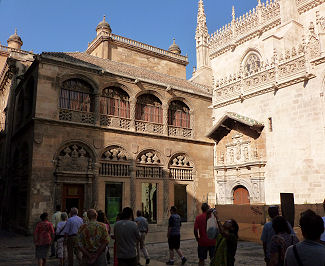
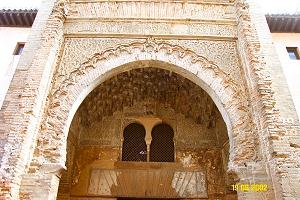
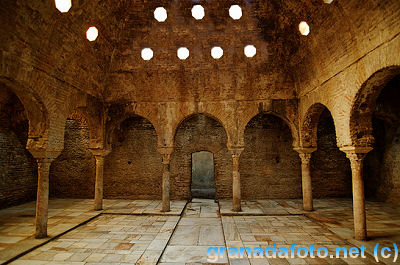
Комментариев нет:
Отправить комментарий